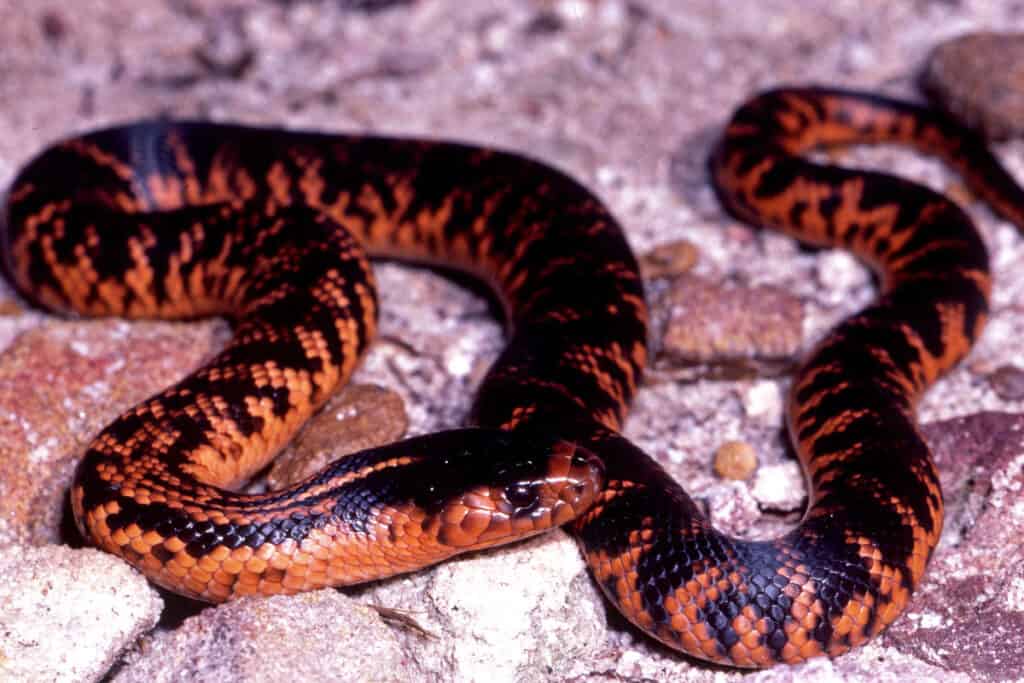Collett’s Snake
Pseudechis colletti
Collett’s snake is beautiful but almost as dangerous as a mulga snake.
Advertisement
Collett’s Snake Facts
Collett’s Snake Physical Characteristics
- Color
- Yellow
- Black
- Dark Brown
- Cream
- Orange
- Pink
- Skin Type
- Scales
- Length
- 5.9 to 7.2 feet
- Venomous
- Yes
- Aggression
- Low
View all of the Collett’s Snake images!
“This snake is one of the most venomous in the world.”
Collett’s snakes, which are a species of black snakes, primarily live in Queensland, Australia, which allows them to be protected by law. This black snake species ranks within the top 20 most venomous snakes in the entire world, and anyone bitten must get treatment with antivenom.
Their reproduction typically occurs in the summertime, taking 91 days for the eggs to hatch after fertilization. However, they sometimes stay in their shell for an additional 12 hours after hatching.
5 Amazing Collett’s Snake Facts
- The closest relative to Collett’s black snake is the blue-bellied black snake.
- The diet of Collett’s snake is carnivorous, primarily feeding on small mammals, reptiles, and amphibians. Though they primarily like to eat local geckos, their diet has been known to include others of their own species.
- During reproduction, one clutch of the Collett’s snake consists of up to 20 eggs. They are fairly easy to breed in captivity.
- The typical reproductive season for the Down’s tiger snake starts between August and October. However, the female doesn’t lay her eggs until nearly two months later, taking an additional three months to hatch.
- During reproduction, the male will crawl on the female’s back, even when newly introduced. It takes up to 6 hours to complete copulation.
Where to Find Collett’s Snakes
The only place Collett’s snakes appear to live is in central-western Queensland in Australia. They are diurnal, which means that the easiest time to spot them during their waking hours is the daytime. They prefer a habitat with plains and other dry or barren regions, though they’ll also live in subtropical climates, shrublands, and low woodlands. Their bright body makes them easy to spot, but their venom should keep you at a healthy distance.
Sometimes, these snakes can be found in trees that provide them with shelter. They’ll seek out homes that have already been prepared by other snakes in trees or on the ground.
Collett’s Snake Scientific Name
The Collett’s snake, which is also called Collett’s black snake, Collett’s cobra, or Down’s tiger snake, has the scientific name Pseudechis colletti. Rather than being Latin or Greek in origin, its name honors Robert Collett, who was a Norwegian zoologist.
This cobra species is of the Elapidae family under the Reptilia class.
Collett’s Snake Population & Conservation Status
So far, the official population of this black snake has not been recorded, but their numbers in captivity are quite high in Victoria. According to the IUCN RedList, the conservation status of Collett’s snake is Least Concern, but all Australian snakes are protected by federal law.
How to Identify Collett’s Snakes: Appearance and Description

Collett’s snakes just want to be left alone
©iStock.com/Ken Griffiths
There is no other species of black snake that is quite as colorful as the Collett’s snake, which makes them incredibly easy to identify. With the upper body colored in dark brown to black, there is a banded pattern in a red to pink hue along the body. Though the head is fairly dark, the tip of their snout is often slightly lighter. Their eyes are always dark brown, encircled by a reddish-brown rim. They have a total of 19 rows of midbody scales with 215-235 ventricle scales.
Juvenile Collett’s cobras are fairly similar in their color pattern, but their brighter colors cause a much starker contrasts in the varied colors. Their physical shape is much like the red-bellied black snake until they are older. When they are born, these snakes are just under a foot long, but they’ll eventually measure 5.9 to 7.2 feet long when they reach adulthood.
How to identify a Collett’s snake:
- Black to brown body with colorful pink or red banding.
- 19 rows of midbody scales.
- Brown eyes with a reddish-brown circle around the iris.
- Dark head with a lighter snout.
- Up to 7.2 feet in length as an adult, just under 1 foot in length as a juvenile.
Collett’s Snake Venom: How Dangerous Are They?
Collett’s snake is extremely venomous, ranking 19th in the world among all venomous snakes. One bite can be fatal, even though it was once thought only to be a minor threat. This lack of information led researchers to learn more, discovering that their venom is directly associated with rhabdomyolysis and acute kidney injury, creating a similar effect to that of a mulga snake. One bite releases about 30 mg of venom, which is cytotoxic.
You might’ve already been bitten by Collett’s snake if you experience nausea, vomiting, abdominal pain, diarrhea, or a headache. If you have been bitten, you need to seek out medical attention within 24 hours to get antivenom specific to black snakes and fluid replacement. Otherwise, you are at risk of rhabdomyolysis, acute kidney injury, or death.
Until help arrives, you should apply pressure to the bitten area and create a tourniquet to prevent the venom from spreading to the rest of your body through the bloodstream. According to the Australian Museum, it shouldn’t restrict blood flow, but it should inhibit movement to keep you still. Keep the bandage on until you reach a hospital.
Collett’s Snake Behavior and Humans
Even though Down’s tiger snakes are bright and beautiful, they are nearly impossible to randomly stumble upon. In fact, the only place you might ever see them is in a zoo or from a breeder because they are routinely sold in captivity as pets. They are neither friendly nor aggressive; they simply want to be left alone whether they are on the ground or in a tree.
Similar Animals
View all 235 animals that start with CCollett’s Snake FAQs (Frequently Asked Questions)
Is the Collett's snake venomous?
Yes. This Australian snake species is incredibly venomous, ranking the 19th-most venomous snake in the world.
Why is it called Collett's snake?
The snake was named by George Albert Boulenger (a Belgian naturalist) as a way to honor Robert Collett (a Norwegian zoologist). Collett was the curator and director of the University of Oslo’s Zoological Museum before he passed in 1913. He is also honored in the name of a reptile – Collett’s skink – which Boulenger also named.
Where do you find Collett's snakes?
Collett’s snakes have only ever been sighted in Queensland. This Australian snake is protected by federal law from being hunted.
What do Collett's snakes look like?
This snake has a dark brown to black body with pink to red banding. It often has a yellow or orange body, ranging from about 6 to 7 feet long.
What do Collett's snake eat?
The diet of a Collett’s snake is fairly varied, including small mammals, reptiles, and amphibians. As a carnivore, they’ll eat any animal that they can, even if that means eating another Collett’s snake.
How do Collett’s snakes hunt?
These snakes slither along the ground in search of their prey. They bite down to incapacitate them with their venom before eating them.
Are Collett’s snakes aggressive?
No. They are quite shy and stay away from humans as much as possible.
Thank you for reading! Have some feedback for us? Contact the AZ Animals editorial team.


















